Some of my Memories
My name is Eric Ellis and I was born at 17 Pinfold Lane in 1940 to Thomas and Edith Maude Ellis. I lived at Pinfold Lane with my brothers Ronald and Brian and my sister Audrey until 1948 when we moved to one of the newly built council houses on Kitson Hill Road. I have only been away from Mirfield for brief periods, always to return.

The Author
As you read these pages you may think that I am saying that things were much better in my youth and I must confess that I believe this was the case for the most part. There was however, one notable exception to this and that was our stretch of the river Calder and the canal. If a person fell into the river they were more likely to die of poisoning than drowning and they would be rushed off to hospital for a series of injections. If anyone should be seen sitting by the side of the river with a fishing rod they could expect to be collected in a green van by men wearing white coats. Today we have reached a point where fishing is once again a normal recreation.
While we are on the subject of pollution, there was another problem of those times that was nationwide but still obviously affected us in Mirfield, and that was thick black fog which later became known as smog. SMOG is an amalgamation of the words SMOKE and FOG and was what happened when particles of soot from the burning of coal by every household and factory in the country got trapped in the minute droplets of water that make up fog. We have all heard the saying, "You couldn't see a hand in front of your face" and I can assure you that in a really bad smog this was an actual fact. I relied on the bus service to get me to and from work in the late 50s and early 60s and still remember the conductor (yes every bus had a conductor then) getting off the bus to walk in front, shining a torch backwards to guide the driver. Because of the industrial nature of our Heavy Woollen District we were afflicted by this as much as, if not more than, other areas of the country. The signs of this pollution were to be seen everywhere: black tree trunks, black walls and black buildings. We thought that black was the natural colour of stone and I remember being amazed later when the programme of sand-blasting buildings revealed the true colour underneath. Even our art for many years had portrayed lots of black smoking chimneys. It was because of the obvious health problems of breathing in this pollution that Britain introduced smokeless zones where the burning of coal was prohibited and only smokeless fuels were allowed. Eventually these zones linked up until the whole country was smokeless.

Street lamp
By way of street lighting we still had the old gas lamp posts. They no longer used gas however and had been converted to electricity with a single bulb in place of the gas mantle which had previously generated a bright white light when heated by the gas flame. We were taught at school about the lamp lighter who went from lamp to lamp at dusk and lit the gas but later versions had a pilot light so were self illuminating when the gas was turned on by a timer. The only attention needed after conversion to electricity was when a bulb would need changing.

Sodium lamp
These lamps were replaced at the end of the 1950s by the yellow sodium lamps and what a revellation they were. The lamp posts were much taller and further apart than their predecessors but the main diffence was that the whole of the road was lit up from end to end rather than just the little patches of light around each lamp that we had been used to. The only down side was that they changed the colour of things so if a car drove past we couldn't say with any certainty what colour it actually was.
If you would like to delve a little deeper into the recent history of Mirfield then I would recommend that you try to find two books by Frances Stott. These are 'Looking Back at Mirfield' and 'Changing Face Of Mirfield'. If they are still in print then they will be available from Mirfield Library and some local newsagents at a low price. You could also try the publisher, Greenfield House Publications, 2 Sandringham Way, Royton, Oldham, OL2 5YH. All profit from these books goes to Yorkshire Cancer Research, The British Heart Foundation, Kirkwood Hospice and MacMillan Nurses. The books are rich with photographic gems of a Mirfield that has now passed by and is only a memory.
For those who wish to go even further back, then H. N. Pobjoy's 'A History of Mirfield' is a must. This book is now out of print but the Library should have a copy on its shelves. This book traces Mirfield from its origins up to around the 1940s and makes great use of the diaries kept by the Rev. Joseph Ismay who was vicar of Mirfield from 1740 to 1778.
Early Memories
My father always kept livestock for as long as I can remember. In the large garden behind the house in Pinfold Lane he had a chicken run. At one time he also had ducks. Just after the war he had a large pig that he kept in an outbuilding attached to the house. At various times he also had goats, which were expert at escaping and we spent many hours trying to track them down. The only time he was without animals or chickens was when we moved to Kitson Hill estate but as soon as an allotment came free at Foxroyd he had chickens again. I still remember him plucking and gutting the occasional fowl and the smell of singeing feathers and the even worse smell as he disposed of the waste products on the open coal fire. He was a keen gardener and provided vegetables for the table but his real passion was his roses that abounded in our front garden.
We used to play around the 'Docky' which was a local name for the area around Taylor Hall Lane. In the centre of the estate of prefabs was a concrete construction which was left over from the war. It was known to us as the tank and its exact use I never knew but it provided a great playground for us. A little later there was a thriving community centre at Taylor Hall Estate and the pictures below are of events that were staged there. Click on them for a larger image and a little more information about each. The photos are reproduced by courtesy of Michael J. Fretwell.
There were also air raid shelters for us to explore. The ones I remember were at Foxroyd near Nab Lane, at the junction of Pratt Lane and Lee Green Road, at the bottom of Old Bank recreation ground and in the grounds of Mirfield Grammar School.
There was also Garforth's quarry in Taylor Hall Lane with a working brick kiln and two ponds on Old Bank Road which were flooded quarries where we caught newts and salamanders. When Kitson Hill Estate was being built there were still fields at Foxroyd. When we moved there, Foxroyd farm was still occupied and there was a working pump with a wheel that could be turned to pump up the water. When the farm was finally vacated we had a free run of the whole area including the stream that ran through the middle of the fields down to Nab Lane. Here we could find frog spawn then tadpoles and eventually tiny frogs.
In the field below the Parish church graveyard is a spring that gives rise to a stream that runs down through the church fields to Ravensthorpe. This stream had thick growths of watercress and we used to search for tadpoles at the appropriate time of year. We spent hours playing in the water on summer days during the long school holidays. The field with the spring was adjacent to the railway cutting which was spanned by a wooden footbridge with swing-gate styles at each end. The railway cutting is now filled in and built on with the houses of Dunbottle Way. The bridge fell into disrepair after the railway disappeared and was removed when it no longer had any purpose.
I've already mentioned elsewhere on this site that my father worked on the railways. This entitled him to various concessionary fares for himself and his family so our family holidays in my early years consisted of a series of day trips since I believe that the cost of travel was probably less than the cost of accommodation. Favourite destinations were Liverpool with a ferry crossing to New Brighton, and Belle Vue Zoo at Manchester. Each day out would start with an early morning walk to Mirfield Station and the excited anticipation while waiting on the platform for the steam train to arrive.
Liverpool and New Brighton: In Liverpool we would visit the cathedral and then take a trip on the overhead railway along the docks marvelling at the multitude of tall cranes that were used to load and unload the ships. This overhead railway has long since past into history.
Then we'd take the British Rail ferry across the Mersey to New Brighton with its sandy beach and large pleasure park. It was at this pleasure park that I first saw — and thrilled at — the Wall of Death with the dare devil motor cyclists hurling their machines around the vertical walls; the roar of the engines and the whole structure shaking as they ran up to the top lip, always threatening to overshoot, but pulling away at the last possible moment.
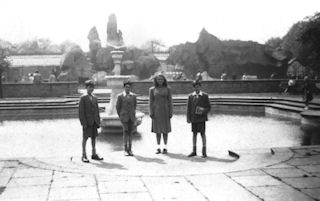
Family outing to Belle Vue around 1950
Some animal houses, enclosures & cafe in the background
Belle Vue, Manchester: In its heyday Belle Vue was one of the biggest leisure parks in Britain. There was a zoo, complete with mangy lions and miserable bears, a huge roller coaster, boating lakes, dodgems, miniature steam railway, and even a speedway racing track.
The roller coaster was called 'The Bobs' and was an old creaking wooden affair. The cars rattled round it, looking like they were about to fall off at any moment. No-one wanted to admit it but 'The Bobs' struck terror in the hearts of many young people.
The zoo followed the old fashioned pattern of small enclosures and cages, and with no room for expansion it was destined to die. Belle Vue closed down during the 1970s. It died because bigger and better attractions had appeared elsewhere; Chester Zoo, Alton Towers, and Blackpool being prime examples.
I do remember one unusual animal there, the tigon, which was the product of mating a male tiger with a lioness. Belle Vue was noted for this and had a succession of tigons between 1936 and 1968.
Later when we started dating we would go dancing at the Glen Ballroom and also at the Drill Hall in Nettleton Road. There were also the Ambulance Rooms at Ravensthorpe where dances were held. Our favourite drinking places on these occasions were The Navigation Tavern, The Black Bull, The Railway, the Bridge Hotel at Hopton and occasionally the Bull's Head at Ravensthorpe where they had a piano that we would all sing along to. We used to pay for our girl friends into the Dance Hall then us boys would get a pass-out and be off to the local pubs until closing time. Strangely enough, the girls would still be waiting when we got back.
Water Royd Lane to Crowlees in the 1950s.
We would leave Kitson Hill estate at Cripple Gate and walk down Water Royd Lane, past the King's Head public house and enter the fields at the Baptist Chapel corner. The path ran left down the side of the first field then turned right at the bottom. There was a distraction on the left at this corner in the shape of a large apple orchard in the grounds of the Murder House. We raided this orchard many times when the apples were ready and there must have been up to 50 trees there.
Continuing along the path, which was bordered on the left by a hedgerow and on the right by a fence, we came to a stone style. Now there was a stone wall on the right, which ran alongside the path and over this wall were 3 or 4 large trees in a row that we used to climb to devour the apples. At this point another path joined ours from the right coming from the handful of houses which comprised West Royd Avenue at that time.
Our route now brought us to a very high wall where the path turned left in front of it. Soon we came to a corner of the wall where it turned at right angles away from the path now bordered on both sides by hedgerows. There were a few gaps in the hedgerow which revealed a tall arched gate through the wall. We would climb the stone wall and peep over to see if the coast was clear then sneak through the gate into the grounds of Westfield House. Here were large greenhouses and pear trees trained along one wall with plum trees along another. This was a much more dangerous place as there was a gardener and it lacked the anonymity of the larger orchard. Also the only escape route was through the gate.
Back on the path we could carry on in a straight line to meet the path which ran from Pratt Lane to the back field of the Grammar School and then Towngate. We would usually turn right here though and the path crossed another field which could contain anything from swedes to wheat depending on the crop for the particular year. At the end of this field was another wall, this time on the left and a row of trees which again could be climbed. The field over this wall is now the playing field of Castle Hall School and the trees have survived. The path finally arrived at the Grammar School and we could go straight on past the entrance of the Memorial Hospital to join Crowlees Road at its junction with Parker Lane where Crowlees Boys' School was then situated. This last short road was unnamed but is now Richard Thorpe Avenue. Alternatively we could turn left onto the path that ran down the back of the Grammar School to Towngate or turn right along the edge of the field to link up with Westfield Road and then to Crowlees Road again.
This journey was completed without passing a single dwelling until Crowlees Road or Towngate was reached.
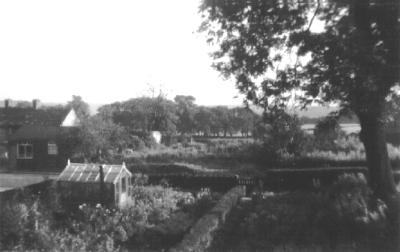
Photograph by courtesy of David Walker
Just above the Shoulder of Mutton public house in Lee Green, there stood two houses — the one further from the pub being home to the Walker brothers, David and Stuart. This photograph is taken from an upstairs window and looks across Lee Green to the open expanse of fields and trees which is now obliterated by West Royd Avenue, Fernhurst Road, Overhall Road, etc. The low, black hut across the road at the left of the photo is Pattinson's fruit and veg shop. Mr. Pattinson lived in the top house of the row just visible beyond the shop. Mr. Pattinson also had a horse and cart from which he sold his green grocery all around Mirfield. Another occupant of this row of houses was Eddie Rigg, our own speedway ace who rode for Odsal Speedway. Eddie had a garage in Little London City, just above Lee Green School where he used to work on his bikes. The ash tree on the right of the picture remained as a feature in the pub car park until recently but had gone at the time of writing this in 2007. The houses themselves were demolished long ago. The photograph just misses Mr. Brearly's spice boiling shop which was next to Mr. Pattinson's shop on its left hand side.
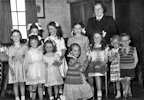
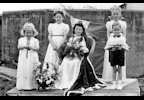
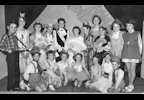 click for larger image
click for larger image